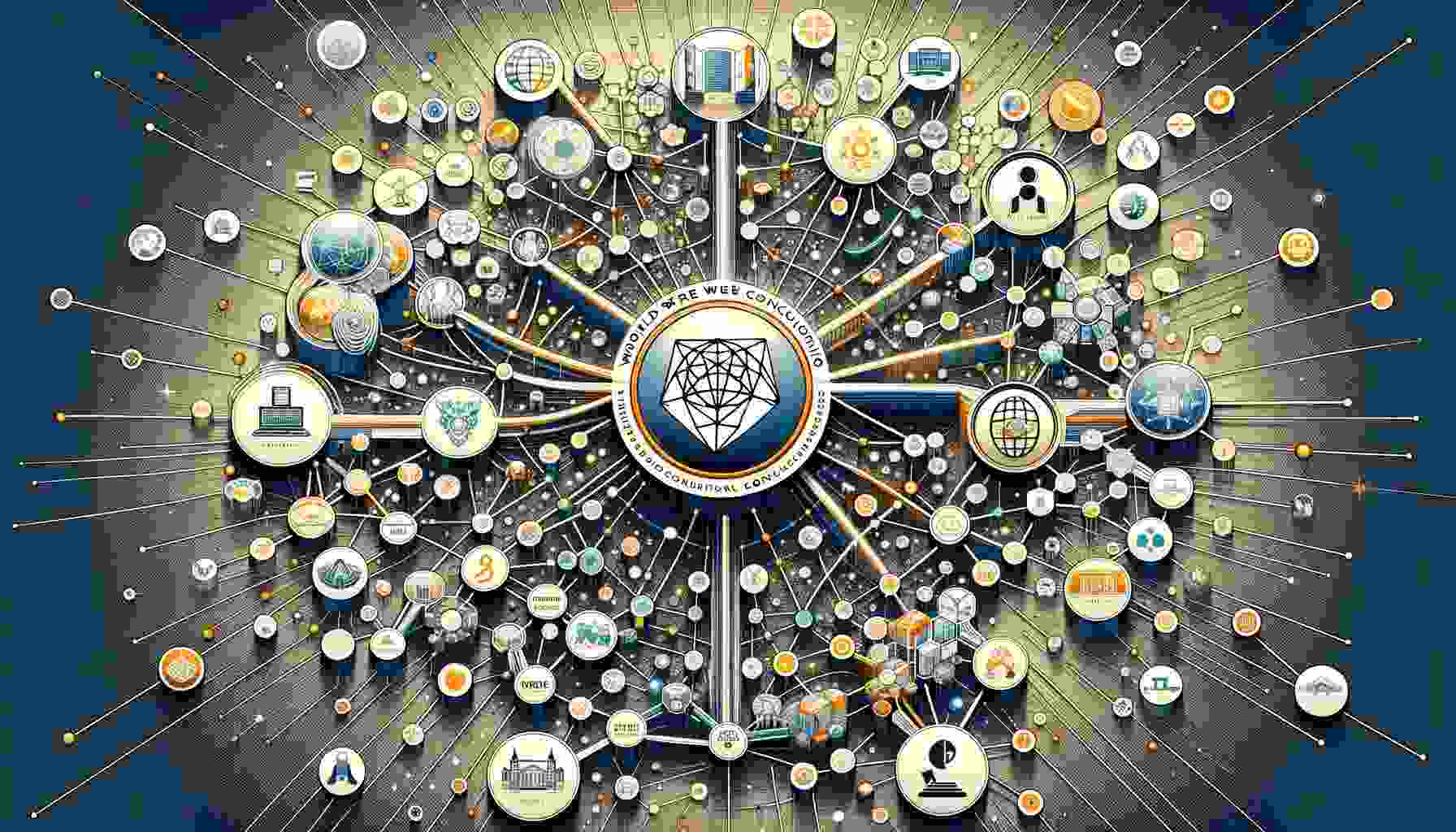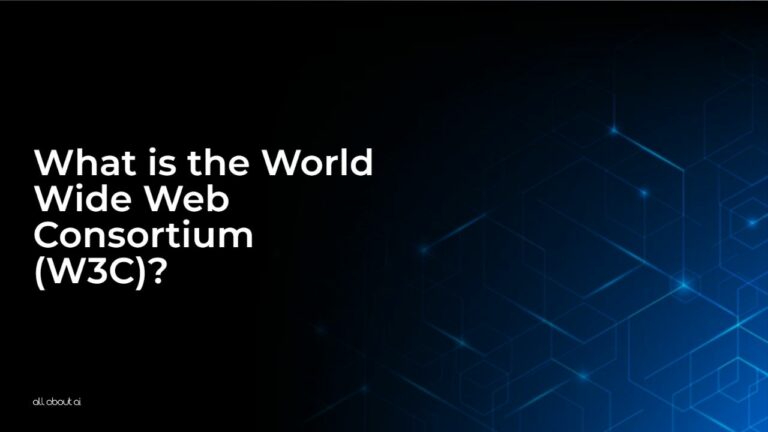What is the World Wide Web Consortium? Commonly known as W3C, it stands as a pivotal beacon in the realm of web standards, ensuring the long-term growth of the Web.
Founded by Tim Berners-Lee, the inventor of the World Wide Web, W3C’s mission is to lead the Web to its full potential by developing protocols and guidelines that ensure the Web’s long-term growth. This includes standards like HTML, CSS, and XML, which are fundamental to web development and accessibility.
Looking to learn more about the W3C? Keep reading this article written by the AI specialists at All About AI.
What is the World Wide Web Consortium?: The Web’s Rule Makers Unmasked!
The World Wide Web Consortium, or W3C for short, is like a big team of people who make sure that the internet works smoothly for everyone. They create rules that help websites and browsers understand each other better, so that all the fun and useful stuff on the internet can grow and everyone can use it easily.
W3C’s Role in Modern Web Development
W3C’s influence in modern web development cannot be overstated. By fostering Web interoperability and promoting web accessibility, W3C ensures that the Web remains open, accessible, and interoperable for everyone around the globe.
This includes the integration of artificial intelligence technologies, where standards play a critical role in enabling machines and humans to interact more seamlessly through the Web.

Champion of Web Standards
W3C, under the guidance of web pioneer Tim Berners-Lee, plays a crucial role in developing core web standards such as HTML, CSS, and XML.
These standards are the bedrock of modern web development, ensuring that web content is universally accessible and compatible across different platforms and devices.
Advocate for Web Accessibility
W3C’s commitment to web accessibility is evident in its Web Accessibility Initiative (WAI), which promotes the design of websites and web tools that are accessible to everyone, including individuals with disabilities. This initiative aligns with W3C’s mission to make the web a more inclusive space.
Facilitator of Web Interoperability
Through its comprehensive standards, W3C ensures web interoperability, allowing diverse web technologies to work together seamlessly.
This interoperability is vital for the integration of new technologies and for the web’s continuous evolution, keeping pace with the demands of its global user base.
Key Standards Developed by W3C
Among the myriad of standards developed by W3C, HTML, CSS, and XML stand out as the cornerstone technologies that enable web developers to create sophisticated, accessible, and visually engaging web experiences.
These standards are continuously evolving to embrace the advancements in web technology and to address the ever-growing needs of the digital world.
HTML: The Foundation of the Web
HTML, or Hypertext Markup Language, is a cornerstone web standard developed by W3C. It provides the basic structure of web pages, enabling the integration of multimedia elements and ensuring the web’s vast repository of information is accessible to all.
CSS: Styling the Web
Cascading Style Sheets (CSS) is another critical standard from W3C, allowing for the separation of presentation and content. CSS enables web designers to create visually engaging web pages and tools like online chatbots that are also efficient and accessible.
XML: Facilitating Data Sharing
Extensible Markup Language (XML) is a flexible text format derived from W3C’s web standards. It plays a pivotal role in the exchange of a wide variety of data on the web and in other networks, enhancing the web’s functionality and interoperability.
Web Accessibility Guidelines
W3C’s Web Content Accessibility Guidelines (WCAG) are part of its initiative to make the web more accessible to people with disabilities. These guidelines are instrumental in helping web developers create content that is accessible to a wider audience.
SVG: Enhancing Web Graphics
Scalable Vector Graphics (SVG) is a W3C standard that describes two-dimensional graphics in XML. SVG allows for high-quality graphics that are scalable and responsive, enhancing the visual experience of web users.
Organizational Structure and Membership
W3C’s organizational structure is a collaborative network of member organizations, including influential tech companies, governmental bodies, and academic institutions.

These members contribute to the W3C mission, fostering the development of web standards that ensure the web remains a universal, accessible, and open platform.
The consortium’s structure encourages innovation and consensus-building among its diverse participants, reflecting the global nature of the web.
Mission and Purpose of W3C
W3C’s mission, envisioned by Tim Berners-Lee, is to lead the web to its maximum potential, focusing on standards that enhance web accessibility, functionality, and interoperability.
The consortium’s work is rooted in the belief that the web is a public good that should empower all individuals.
By prioritizing web standards and accessibility, W3C ensures that the web remains an inclusive resource, capable of evolving with technological advancements while maintaining its foundational principles.
How to Get Involved with W3C
Getting involved with W3C is a pathway for individuals and organizations to contribute to the evolution of the Web.
Participation can take various forms, from contributing to discussions on web standards, joining a W3C group, to participating in W3C events and workshops.
This involvement is crucial for ensuring that the Web remains a dynamic and inclusive platform for innovation.
- Explore W3C Community Groups: Start by engaging with one of the many W3C Community Groups focused on various aspects of web technology, from web accessibility to emerging web standards.
- Participate in Open Discussions: Join the dialogue on W3C’s public mailing lists and forums, contributing to the discourse on web standards and accessibility.
- Attend W3C Workshops and Conferences: These events are excellent opportunities for networking with web professionals and learning more about W3C’s ongoing work.
- Consider Membership: Organizations can become W3C members, contributing directly to the development of web standards and influencing the future direction of the web.
The Future of Web Standards with W3C
As we look towards the future, W3C’s role in shaping web standards is more critical than ever, especially with the increasing integration of AI into web technologies.
The consortium continues to adapt and evolve, ensuring that web standards not only meet the current needs of developers and users but also anticipate future trends and challenges in the digital landscape.

- Enhanced Web Accessibility: Building on its WAI guidelines, W3C will continue to advance web accessibility, ensuring that future web technologies are accessible by design.
- Evolution of HTML and CSS: As foundational web standards, HTML and CSS will evolve to meet the demands of modern web development, incorporating new features for richer, more interactive web experiences.
- Advancements in Web Security: W3C will focus on developing standards that bolster web security, protecting user data and privacy in an increasingly connected world.
- Interoperability in the Age of AI: With AI and machine learning becoming integral to web technologies, W3C will play a key role in ensuring these advanced systems work seamlessly within the web ecosystem.
- Sustainable Web Practices: Recognizing the environmental impact of web technology, W3C is likely to focus on standards that promote sustainability and reduce the carbon footprint of web operations.
Want to Read More? Explore These AI Glossaries!
Step into the enthralling domain of AI with our in-depth glossaries, perfectly structured for learners ranging from curious starters to advanced practitioners. Use this guide as an indispensable reference to decode the complex subtleties and innovative breakthroughs in artificial intelligence.
- What is Ontology?: Simply put, it refers to a structured framework that categorizes and organizes information.
- What is Ontology Learning?: At its core, it involves the automated extraction, construction, and updating of ontologies.
- What is OpenAI?: OpenAI, a name synonymous with cutting-edge artificial intelligence, represents the forefront of AI research and development.
- What is OpenCog?: Distinguished by its ambitious goal, it seeks to create a general intelligence framework, designed to equip machines with learning, reasoning, and understanding capabilities akin to human cognitive abilities.
- What is Open Data?: What is open data? It refers to the concept of making data freely available to everyone, without any copyright or licensing restrictions.
FAQs
What is the difference between WWW and W3C?
Why do we need Web standards by W3C?
How do I know if my website is W3C compliant?
What are the 3 web standards?
Wrap Up
The World Wide Web Consortium (W3C) is more than an organization; it’s a driving force behind the open, accessible, and interoperable Web we rely on today. As the digital landscape continues to evolve, particularly with advancements in AI, W3C’s role in developing and refining web standards remains indispensable.
This article was written to answer the question, “what is the world wide web consortium.” Looking to learn more about the wider world of AI? Read through the rest of the articles in our AI Dictionary.





